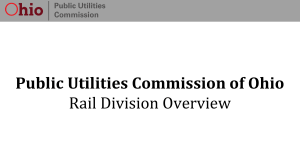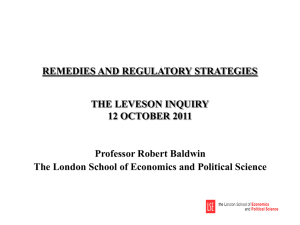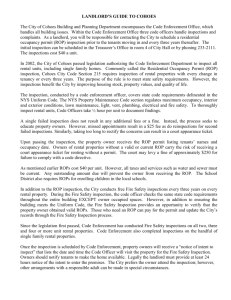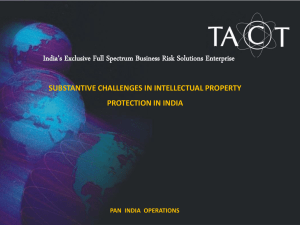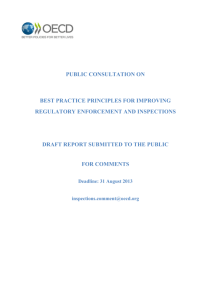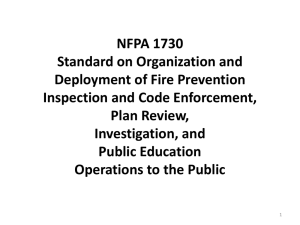Document
advertisement
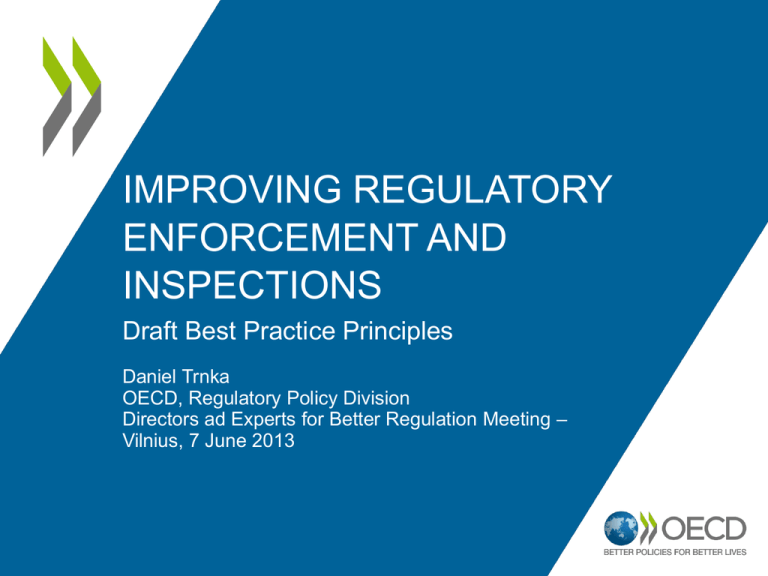
IMPROVING REGULATORY ENFORCEMENT AND INSPECTIONS Draft Best Practice Principles Daniel Trnka OECD, Regulatory Policy Division Directors ad Experts for Better Regulation Meeting – Vilnius, 7 June 2013 Regulatory compliance & enforcement • Compliance crucial for regulatory efficiency • A phase of the Regulatory Governance Cycle that have been addressed less systematically • Emerging issue –reforms in the area of inspections, innovations, governance arrangements for regulators • Insufficient contact between those responsible for regulatory policy and regulators/inspectors who have front-line experience with implementation Some key findings from the OECD survey on inspections and enforcement • 50% of respondents did not have cross sectoral policies for organising inspection authorities. • 58% do not have policies to reform inspection functions. • 79% do not hold a central register of inspection authorities. • Performance of inspection authorities isn't measured consistently or transparently. • Accountability lines and the level of independence varies. • 50% of respondents do not have to co-ordinate amongst themselves to avoid duplication. • Inspectors behaviour is key to improving compliance with the majority of businesses needing advice. • Inspection plans are not generally communicated. OECD Principles - background • OECD was asked to develop a set of best practice principles on improving enforcement and inspections • Main goals are to: • Summarise existing knowledge and good practice • Present some overarching, common principles that can be • • used by policy-makers and “smart regulators” Promote inspection reforms Give those countries that are starting/considering such reforms a comprehensive guidance • Draft based on the 2012 OECD survey, two expert papers, existing documentation and experience of non-OECD countries 4 Improving policies, institutions and practices (1) • Draft principles cover the whole set of issues that allow to sustainably improve regulatory enforcement and inspections – making them more effective, efficient and transparent • Policies: • • • • • Evidence- and measurement-based enforcement/inspections Use enforcement/inspections only where strictly necessary Risk-based and proportionate enforcement “Responsive Regulation” approach Institutions: • Stable institutional mechanism for reform/improvements • Consolidation/coordination of inspection functions • Governance +HR policies geared towards professionalism, outcomes 5 Improving policies, institutions and practices (2) • Tools: • Over-arching aims: maximize positive outcomes, minimize costs and burdens • IT to ensure risk focus, coordination, information sharing • Clarity and rules of processes • Promote transparency and compliance through toolkits, check-lists etc. 6 1 - Evidence-based and measurement-based • Do not inspect and actively enforce “everything that is regulated” • Rather, evaluate the risk level posed by different types of regulations and regulated areas • Allocate resources and efforts proportionally to potential outcomes • Evaluate and adjust based on results 7 2 – Whenever possible, “alternatives to enforcement” should be explored • Market forces, civil litigation etc. all have considerable power to prevent negative outcomes or enforce rules • State-driven inspections and enforcement should only be used when these alternatives are demonstrably absent or insufficient • In any case, stakeholders need to be involved – compliance and outcomes cannot be obtained purely “by force” 8 3 – Proportionate and risk-based • Frequency of inspections should be proportionate to risk level • Severity of sanctions and burden of enforcement should be proportionate to actual hazard/damage • Risk = probability x magnitude (scope x severity) of hazard 9 4 – “Responsive Regulation” • Enforcement modulated based on behaviour of regulated entities • “Honest mistakes” and one-off violations treated differently from systematic, criminal misconduct • Aim: promote compliance and positive outcomes 10 5 – Clear objectives and stable institutional mechanism to drive improvements • Official policy, clear objectives for continued improvements in enforcement – long term perspective • Institutional set-up gathering all relevant ministries, institutions, stakeholders • Strong policy leadership 11 6 – Consolidation and coordination of inspection functions • Less duplication and overlaps – reduced costs and burden • Greater coherence, better information flow – more effectiveness • Core list of inspection/enforcement functions to match rational analysis of types of risks – not “historical” list of institutions 12 7 – Governance and HR policies to support professionalism, outcomes orientation • Governance: put inspections/enforcement “at arm’s length” from political decisions for day-to-day operations – give more stability to institutions through collective governance • Ensure professionalism in recruitments and in particular for top management • HR policies, performance measurement etc. to support improvements, promote outcome-orientation • Inspectors’ training needs to incorporate risk-management, compliance-promotion, and a whole set of “competencies” related specifically to enforcement • Aim to increase consistency, quality – reach better outcomes 13 8 – Information technology for coordination, information-sharing, risk-focus • Interconnect databases and systems used by different inspectorates / whenever possible set up single/joint systems • Data sharing and shared planning mean less duplication, more efficiency – but also better outcomes because key information is shared effectively, risks are better identified • Initial investment can deliver considerable benefits and efficiencies 14 9 – Clarity of rules and process • Framework legislation/regulations to ensure that inspections/enforcement process are clear and consistent • Rights and obligations of all parties and stakeholders to be clarified – and abuses prevented 15 10 – Promote compliance and transparency through toolkits, check-lists etc. • Ensure that regulated subjects know what is expected from them • Enforcement to be consistent and predictable • Compliance promotion achieves better outcomes at lower costs • Tools adapted to different types and profiles of establishments 16 Further process • The draft should serve as a basis for triggering discussion • Set of principles plus explanatory texts summarising main issues • OECD Regulatory Policy Committee agreed with publication for comments • The draft is be published on our website, the consultations will be advertised and widely promoted • We would like to ask you to kindly do the same in your countries 17 Questions for discussion • Is the document fit for its purpose? • Do the principles sufficiently describe all the issues important for effective regulatory enforcement and inspections? • If not, which issues should be added? Which ones should be taken out? • Do the principles provide sufficient guidance for reformers? • How do these principles relate to the practice in your country? 18 THANK YOU! daniel.trnka@oecd.org www.oecd.org/regreform
